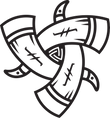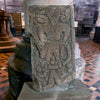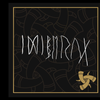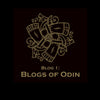The world's oldest datable rune stone has been found in Norway
- by Alyssa Nilsen

An ancient runestone is currently the centre of attention amongst historians and linguistics worldwide.
Discovered in 2021 while excavating a grave field at Hole in Ringerike, eastern Norway, making way for a new tunnel, a stone with runic carvings, bones and charcoal was found inside a cremation pit. The stone, a sandstone measuring 31xm x 32cm, was discovered to have multiple runic carvings on it, some easier to distinguish than others.
After carbon dating the stone and bones, the conclusion was clear: The Svingerud Stone (named after its discovery location) is not only among the oldest runestones ever discovered, but it is also the oldest datable runestone in the world! In Norway, only 30 other runestones have been preserved from the first few centuries up to around 500/550 CE. Only very rarely are new discoveries made of stones with inscriptions in the older futhark. and the Svingerud stone is the only one dating to earlier than the year 300, probably from some time between 0-250 AD. Sometime between 1800-2000 years ago, someone speaking an early proto-nordic language carved signs into a stone, which was then concealed for up to two millennia before once again being uncovered.
This means that the runes scribbled on the stone are from the earliest age of runes the way we know them, making them challenging to interpret. What language did they speak? Were they trained in the written language they wrote, or were they going by the sounds the words made? Did they write in a dialect, unlike anything we know of today?

In an extensive thread on Twitter, Runologist Kristel Zilmer, professor in written culture and iconography at the Museum of Cultural History, University of Oslo, who has spent the past couple of years studying the stone and its carvings in depth, explains how on the front of the stone, eight runes stand out: Converted to Latin, they spell “idiberug”, possibly “idibera” (The final rune could be a reversed 'n', but the shape itself is closest to 'g'), which could be a name, possibly of the young adult buried there. This may contain a case form of the name Idibera, saying: ‘For Idibera’. Other options are Idibergu/Idiberga, or the kin name Idiberung. Some runes may have their order altered; some may be missing.
The way of writing older runes varied a lot depending on geographic location, teaching, and memory. There were no centralised rules or text to reference. In addition, the language changed drastically from the time carved through the Viking Age to the Medieval Age, making interpreting the runes even more difficult.

In addition to the (potential) name, the stone had several other inscriptions. Among them are the first three letters of Futhark, the runic alphabet, ᚠ (f), ᚢ (u) and ᚦ (th). One B is extra fascinating, as it is made up of 4 pockets (not two), effectively stacking 2 Bs on top of each other.
Some engravings form grid patterns, zig-zag figures and other interesting markings though not all of them make immediate sense.
“There is almost an impression that someone has copied, explored or played with writing. Maybe someone was learning how to carve runes?” Zilmer says.
On twitter, she explains that: “The stone looks very different from what we would expect to find on early runic objects, in particular stones. Its collection of inscriptions brings to mind quickly sketched wall graffiti rather than a stone memorial.”
The work to decipher the secrets of the stone is far from over, and Zilmer, along with her team of experts in runology, archaeology, language history, name studies, and digital documentation, will be releasing plenty of new findings over the next few years.
“To the left on the stone, there are two short lines of runes. In addition, some twenty runes run along one narrow side. The line there has numerous consonants and only a few vowels. Further work will show whether it contains an understandable message.”

The discovery of this runestone places runes and written language in Norway at a much earlier time in history than previously presumed. There is no saying what the team is going to uncover over the coming months and years, but it could change our entire understanding of proto-Nordic traditions, cultures and languages. We’ll keep you updated with news as soon as they come in.
All photos: Kristel_Zilmer, Kulturhistorisk Museum and Universitetet i Oslo
- Posted in:
- archeology
- history
- linguistics
- The Svingerud Stone



